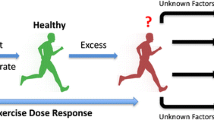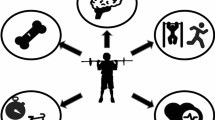Abstract
Resistance training (RT) is a popular method of conditioning to enhance sport performance aswell as an effective form of exercise to attenuate the age-mediated decline in muscle strength and mass. Although the benefits of RT on skeletal muscle morphology and function are well established, its effect on left ventricular (LV) morphology remains equivocal. Some investigations have found that RT is associated with an obligatory increase in LV wall thickness and mass with minimal alteration in LV internal cavity dimension, an effect called concentric hypertrophy. However, others report that short- (<5 years) to long-term (>18 years) RT does not alter LV morphology, arguing that concentric hypertrophy is not an obligatory adaptation secondary to this form of exertion. This disparity between studies on whether RT consistently results in cardiac hypertrophy could be caused by: (i) acute cardiopulmonary mechanisms that minimise the increase in transmural pressure (i.e. ventricular pressure minus intrathoracic pressure) and LV wall stress during exercise; (ii) the underlying use of anabolic steroids by the athletes; or (iii) the specific type of RT performed. We propose that when LV geometry is altered after RT, the pattern is usually concentric hypertrophy in Olympic weightlifters. However, the pattern of eccentric hypertrophy (increased LV mass secondary to an increase in diastolic internal cavity dimension and wall thickness) is not uncommon in bodybuilders. Of particular interest, nearly 40% of all RT athletes have normal LV geometry, and these athletes are typically powerlifters. RT athletes who use anabolic steroids have been shown to have significantly higher LV mass compared with drug-free sport-matched athletes. This brief review will sort out some of the factors that may affect the acute and chronic outcome of RT on LV morphology. In addition, a conceptual framework is offered to help explain why cardiac hypertrophy is not always found in RT athletes.







Similar content being viewed by others
References
Kraemer WJ, Adams K, Carafelli E, et al. American College of Sports Medicine position stand: progression models in resistance training for healthy adults. Med Sci Sports Exerc 2002; 34: 364–80
Fiatarone MA, Marks EC, Ryan ND, et al. High-intensity strength training in nonagenarians: effects on skeletal muscle. JAMA 1990; 263: 3029–34
Fagard RH. Athlete’s heart: a meta-analysis of the echocardiographic experience. Int J Sports Med 1996; 17 Suppl. 3: S140–4
Pluim BM, Zwinderman AH, van der Laarse A, et al. The athlete’s heart: a meta-analysis of cardiac structure and function. Circulation 2000; 101: 336–44
Haykowsky MJ, Gillis R, Quinney A, et al. Left ventricular morphology in elite female resistance-trained athletes. Am J Cardiol 1998; 82: 912–4
Haykowsky MJ, Quinney HA, Gillis R, et al. Left ventricular morphology in junior and master resistance trained athletes. Med Sci Sports Exerc 2000; 32: 349–52
Haykowsky MJ, Teo KK, Quinney AH, et al. Effects of long term resistance training on left ventricular morphology. Can J Cardiol 2000; 16: 35–8
Urhausen A, Kindermann W. Sports-specific adaptations and differentiation of the athlete’s heart. Sports Med 1999; 28: 237–44
Wagman DF, Curry LA, Cook DL. An investigation into anabolic androgenic steroid use by elite U.S. powerlifters. J Strength Cond Res 1995; 9: 149–54
MacDougall JD, Tuxen D, Sale DG, et al. Arterial blood pressure responses to heavy resistance training. J Appl Physiol 1985; 58: 785–90
Fleck SJ, Dean LS. Resistance-training experience and the pressor response during resistance exercise. J Appl Physiol 1987; 63: 116–20
Palatini P, Mos L, Munari L, et al. Blood pressure changes during heavy-resistance exercise. J Hypertens Suppl 1989; 7: S72–3
MacDougall JD, McKelvie RS, Moroz DE, et al. Factors affecting blood pressure during heavy weight lifting and static contractions. J Appl Physiol 1992; 73: 1590–7
McCartney N, McKelvie RS, Martin J, et al. Weight-training induced attenuation of the circulatory response of older males to weight lifting. J Appl Physiol 1993; 74: 1056–60
Lentini AC, McKelvie RS, McCartney N, et al. Left ventricular response in healthy young men during heavy-intensity weight-lifting exercise. J Appl Physiol 1993; 75: 2703–10
Hamilton WF, Woodbury RA, Harper HT. Physiologic relationships between intrathoracic, intraspinal and arterial pressures. JAMA 1936; 107: 853–6
Haykowsky M, Taylor D, Teo K, et al. Left ventricular wall stress during leg-press exercise performed with a brief Valsalva maneuver. Chest 2001; 119: 150–4
Galanti G, Comeglio M, Vinci M, et al. Non-invasive left ventricular wall stress evaluation during isometric exercise in trained subjects. Int J Sports Cardiol 1992; 1: 89–93
Abinader EG, Sharif D, Sagiv M, et al. The effects of isometric stress on left ventricular filling in athletes with isometric or isotonic training compared to hypertensive and normal controls. Eur Heart J 1996; 17: 457–61
Deligiannis A, Zahopoulou E, Mandroukas K. Echocardiographic study of cardiac dimensions and function in weight lifters and body builders. Int J Sports Cardiol 1988; 5: 24–32
Fleck SJ, Bennett III JB, Kreaemer WJ, et al. Left ventricular hypertrophy in highly strength trained males. In: Lubich T, Venerando A, Zepelli P, editors. Sports Cardiology 2nd International Congress; 1987; Sorrento. Bologna: Aulo Gaggi Publisher, 1987: 303–12
George KP, Batterham AM, Jones B. The impact of scalar variable and process on athlete-control comparisons of cardiac dimensions. Med Sci Sports Exerc 1998; 30: 824–30
Huonker M, Halle M, Keul J. Structural and functional adaptations of the cardiovascular system by training. Int J Sports Med 1996; 17 Suppl. 3: S164–72
Lattanzi F, Di Bello V, Picano E, et al. Normal ultrasonic myocardial reflectivity in athletes with increased left ventricular mass: a tissue characterization study. Circulation 1992; 85: 1828–34
Pavlik G, Olexo Z, Osvath P, et al. Echocardiographic characteristics of male athletes of different age. Br J Sports Med 2001; 35: 95–9
Sagiv M, Sagiv A, Ben Sira D, et al. Effects of chronic overload training and aging on left ventricular systolic function. Gerontology 1997; 43: 307–15
Spataro A, Pellicia A, Caselli G, et al. Echocardiographic standards in top-class athletes. J Sports Card 1985; 2: 17–27
Suman OE, Hasten D, Turner MJ, et al. Enhanced inotropic response to dobutamine in strength-trained subjects with left ventricular hypertrophy. J Appl Physiol 2000; 88: 534–9
Takala TO, Nuutila P, Knuuti J, et al. Insulin action on heart and skeletal muscle glucose uptake in weight lifters and endurance athletes. Am J Physiol 1999; 276: E706–11
Colan SD, Sanders SP, Borow KM. Physiologic hypertrophy: effects on left ventricular systolic mechanics in athletes. J Am Coll Cardiol 1987; 9: 776–83
Longhurst JC, Kelly AR, Gonyea WJ, et al. Echocardiographic left ventricular masses in distance runners and weight lifters. J Appl Physiol 1980; 48: 154–62
Pearson AC, Schiff M, Mrosek D, et al. Left ventricular diastolic function in weight lifters. Am J Cardiol 1986; 58: 1254–9
Roy A, Doyon M, Dumesnil JG, et al. Endurance vs strength training: comparison of cardiac structures using normal predicted values. J Appl Physiol 1988; 64: 2552–7
Snoeckx LH, Abeling HF, Lambregts JA, et al. Echocardiographic dimensions in athletes in relation to their training programs. Med Sci Sports Exerc 1982; 14: 428–34
Bertovic DA, Waddell TK, Gatzka CD, et al. Muscular strength training is associated with low arterial compliance and high pulse pressure. Hypertension 1999; 33: 1385–91
Brown SP, Thompson WR. Standardization indices of cardiac hypertrophy in weight lifters. J Sports Sci 1987; 5: 147–53
Fleck SJ, Henke C, Wilson W. Cardiac MRI of elite junior Olympic weight lifters. Int J Sports Med 1989; 10: 329–33
Manari A, Gaddi O, Guiducci U. Cardiovascular responses to isometric exercise in hearts of power and endurance athletes. Int J Sports Cardiol 1987; 4: 90–5
George KP, Batterham AM, Jones B. Echocardiographic evidence of concentric left ventricular enlargement in female weight lifters. Eur J Appl Physiol Occup Physiol 1998; 79: 88–92
George KP, Wolfe LA, Burggraf GW, et al. Electrocardiographic and echocardiographic characteristics of female athletes. Med Sci Sports Exerc 1995; 27: 1362–70
Pelliccia A, Spataro A, Caselli G, et al. Absence of left ventricular wall thickening in athletes engaged in intense power training. Am J Cardiol 1993; 72: 1048–54
Falkel JE, Fleck SJ, Murray TF. Comparison of central hemodynamics between powerlifters and body builders during resistance exercise. J Appl Sport 1992; 6: 24–35
Bella JN, Wachtell K, Palmieri V, et al. Relation of left ventricular geometry and function to systemic hemodynamics in hypertension: the LIFE Study. Losartan Intervention for Endpoint Reduction in Hypertension Study. J Hypertens 2001; 19: 127–34
Sachtleben TR, Berg KE, Elias BA, et al. The effects of anabolic steroids on myocardial structure and cardiovascular fitness. Med Sci Sports Exerc 1993; 25: 1240–5
Dickerman RD, Schaller F, Zachariah NY, et al. Left ventricular size and function in elite bodybuilders using anabolic steroids. Clin J Sport Med 1997; 7: 90–3
Sader MA, Griffiths KA, McCredie RJ, et al. Androgenic anabolic steroids and arterial structure and function in male bodybuilders. J Am Coll Cardiol 2001; 37: 224–30
McKillop G, Todd IC, Ballantyne D. The effects of body building and anabolic steroids on left ventricular structure and function. J Cardiovasc Technol 1989; 8: 23–9
Urhausen A, Holpes R, Kindermann W. One- and two-dimensional echocardiography in bodybuilders using anabolic steroids. Eur J Appl Physiol Occup Physiol 1989; 58: 633–40
De Piccoli B, Giada F, Benettin A, et al. Anabolic steroid use in body builders: an echocardiographic study of left ventricle morphology and function. Int J Sports Med 1991; 12: 408–12
Deligiannis A, Mandroukas K. Noninvasive cardiac evaluation of weight-lifters using anabolic steroids. Scand J Med Sci Sports 1992; 3: 37–40
Di Bello V, Giorgi D, Bianchi M, et al. Effects of anabolic-androgenic steroids on weight-lifters’ myocardium: an ultrasonic video densitometric study. Med Sci Sports Exerc 1999; 31: 514–21
Sagiv M, Shapiro Y, Ben-Sira D, et al. Effect of isometric vs running training programs on left ventricular and hemodynamic alterations at rest on healthy adolescent girls. Int J Sports Cardiol 1986; 3: 30–4
Ricci G, Lajoie D, Petitclerc R, et al. Left ventricular size following endurance, sprint, and strength training. Med Sci Sports Exerc 1982; 14: 344–7
Lusiani L, Ronsisvalle G, Bonanome A, et al. Echocardiographic evaluation of the dimensions and systolic properties of the left ventricle in freshman athletes during physical training. Eur Heart J 1986; 7: 196–203
Kanakis C, Hickson RC. Left ventricular responses to a program of lower-limb strength training. Chest 1980; 78: 618–21
Mandecki T, Foji E, Mandecki M, et al. Left ventricular function in weight lifters and distance runners: the influence of anabolic hormones. In: Hermans GP, editor. Sports, medicine and health. Kent: Elsevier Science, 1990: 870–5
Sagiv M, Fisher N, Yaniv A, et al. Effect of running versus isometric training programs on healthy elderly at rest. Gerontology 1989; 35: 72–7
Haykowsky M, Humen D, Teo K, et al. Effects of 16 weeks of resistance training on left ventricular morphology and systolic function in healthy men >60 years of age. Am J Cardiol 2000; 85: 1002–6
Hagerman FC, Walsh SJ, Staron RS, et al. Effects of high-intensity resistance training on untrained oldermen. I: Strength, cardiovascular, and metabolic responses. J Gerontol A Biol Sci Med Sci 2000; 55 (7): B336–46
Nishimura T, Yamada Y, Kawai C. Echocardiographic evaluation of long-term effects of exercise on left ventricular hypertrophy and function in professional bicyclists. Circulation 1980; 61: 832–40
Acknowledgements
The authors have provided no information on sources of funding or on conflicts of interest directly relevant to the content of this review.
Author information
Authors and Affiliations
Corresponding author
Rights and permissions
About this article
Cite this article
Haykowsky, M.J., Dressendorfer, R., Taylor, D. et al. Resistance Training and Cardiac Hypertrophy. Sports Med 32, 837–849 (2002). https://doi.org/10.2165/00007256-200232130-00003
Published:
Issue Date:
DOI: https://doi.org/10.2165/00007256-200232130-00003




